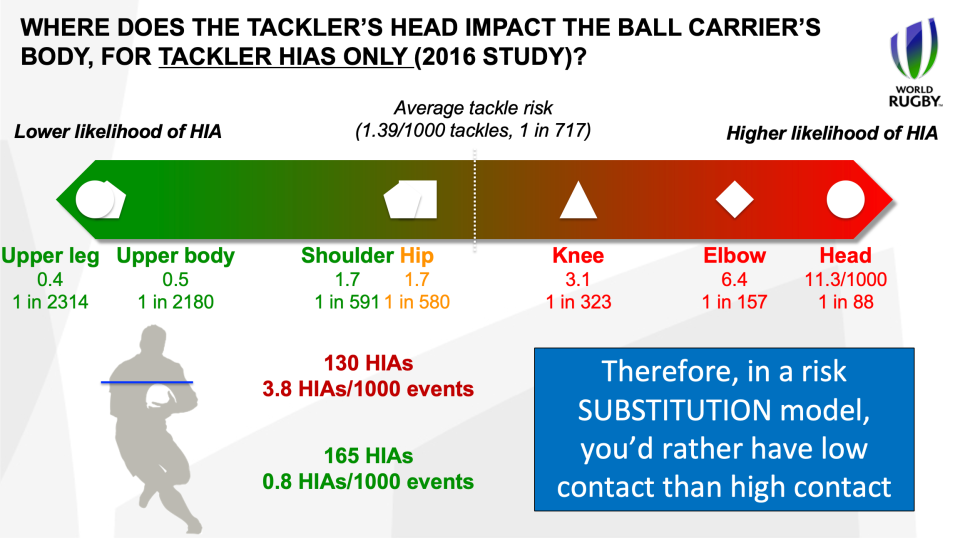World Rugby should be taking the lead on tackle heights, not following

It is the work of just a minute or two to create a petition on the Change.org website, to be one of the ‘people taking action’ whose signatures the public-benefit corporation claims to be turning into ‘victories every day’. Takes only a few seconds to add a signature to a petition.
By contrast, seven years of analysis lies behind the Rugby Football Union’s planned changes to the tackle rules in the community game that are designed to reduce the incidence of head injuries. So, do we follow the science or the crowd?
A week on from the RFU’s announced changes, which lower the permitted height of a tackle to the waist from next season, a petition launched by Ed Bartlett, a player for Old Reigatians in rugby’s level six, has garnered 70,416 signatures and counting. That’s probably more than will turn out to play the game in England this coming weekend.
A few disclaimers first. As a schoolboy I was hopeless at rugby. Four-eyed, scrawny and slow, there was no position I could fill in any team productively. As chair now of GB Wheelchair Rugby, I’m enormously grateful to the RFU for the support they give us.
But regular readers will know I’m no apologist for the governing body – far from it on occasion. As a sports leader, I’ve been on the receiving end of grassroots backlashes in the past, including via petition, so I’m familiar with the difficult position the RFU has placed itself in.
The science that the RFU is following is being paraded by a World Rugby employee, Dr Ross Tucker. It is rich in data, not only from matches under the existing rules, but also from countries that have already restricted tackle heights – in particular France, which is three seasons ahead of England.
The RFU told me this week it considers the evidence “compelling and substantial” such that it is “impossible to do nothing”. Ticker says: “The data is so clear – if the head of the tackler is in proximity or contact with the ball carrier the risk [of head injury] is 4x higher.” His analysis can be read in detail here.
Tucker concludes that tackles to the torso are optimal as measured by the prevalence of head injuries, only leaving open whether the sternum or the waist should mark the height restriction. The former carries more risk of accidental head collision; the latter of head to knee contact.
The graphic below shows the spectrum of risk of triggering head injury assessments (HIAs) for tacklers across the different impact zones that Tucker cites.

Useless I may have been, but I still remember well the repeated imprecations of PE teachers to tackle low in order to get my arms wrapped around the lower legs of the opponents who trampled over me.
The sport has changed dramatically in the decades since; indeed has been the subject of repeated tinkering with the rules. But it is still recognisably rugby union. I therefore take with a hefty scoop of salt some players’ claims that the rule change will drive them out of the community game.
Ed Bartlett in his petition asserts that “generations of people growing up will be lost to the game”. I’d say that’s already happening, for a wide variety of reasons. One of which may well be anxious parents reluctant to expose their offspring to perceived risks in rugby, including head injuries.
Only three weeks ago in Sport inc. I highlighted that the number of adults playing rugby regularly has halved over the past five years, and not just because of Covid. Many clubs are now struggling to put out full sides each weekend through the season.
Rugby must adapt in a variety of ways if it is to rebuild its core base within schools and the community game. A proactive approach to player welfare must surely be an important factor.
Ross Tucker makes clear that the French experience shows there will be early difficulties in implementing a new tackle height rule. Players, coaches and officials all need to adapt. There will be frustration. Bedding in understanding and ingraining new habits will take more than a season, but what emerges will still be unambiguously rugby union.
Surely the international federation should be taking the lead in this though, not being a follower, especially as their own scientist is the man who’s currently being drop-kicked by the disgruntled of England.
Ed Warner
Perhaps the RFU could have consulted more widely before reaching its decision – a charge being laid at its door now by many. But sometimes decisiveness is paramount.
The very length of the list of signatures on the petition suggests that a widespread consultation process would simply have bogged down the governing body and the whole sport for, potentially, a season or two with little prospect of harmony eventually breaking out anyway. The RFU should stick to its guns.
You might ask where World Rugby is in all of this. Strikes me they are conducting a barely controlled experiment by allowing individual countries to adopt different tackle rules. New Zealand, for example, has drawn the line at the sternum not the waist.
In time, World Rugby will doubtless impose a global change to permitted tackle heights based on the differing experiences of its member nations, and extend it to the elite game. This will benefit most that country whose approach happens to be the one adopted worldwide.
Surely the international federation should be taking the lead in this though, not being a follower, especially as their own scientist is the man who’s currently being drop-kicked by the disgruntled of England.
Bad medicine
Scientists don’t always point you in the right direction. Seb Coe says World Athletics will “follow the science” in proposing new regulations that will permit trans women to compete in female track and field events, dependent on their testosterone levels.
I don’t agree with those who believe this would destroy female athletics, but it would only take one or two high profile successes by trans athletes to distort the perceived integrity of competition. After all, even World Athletics concedes that male puberty can bestow lasting physiological advantages for those subsequently competing in female sport.
Lord Coe can usually bend the 214 member nations of World Athletics to his will when his council presents them with recommendations. Maybe not this time though.
A fool and his money
If you were a multi-billionaire, would you rather buy a Premier League club with great infrastructure or one with a great squad (if you couldn’t find one for sale with both)?
Todd Boehly’s consortium spent £2.5bn to buy Chelsea and has already splashed over £400m on new players to bolster the club’s bloated roster.
Agreeing contracts of eight years or more is spreading Chelsea’s amortisation of transfer fees over longer than usual periods, but surely stores up financial trouble for the future.
Already Uefa is said to be likely to tighten its Financial Fair Play regulations to rule out such lengthy deals – or at least their effect on the FFP maths.
Manchester United is up for sale. Liverpool’s owners are seeking outside investment. There is Qatari interest in Tottenham Hotspur.
Each club can be said to need squad investment – but isn’t that always the case, if not today then tomorrow? Each, though, has a very different physical asset base.
Spurs has the state of the art stadium, Liverpool’s has been redeveloped, United’s is in need of a major overhaul, and Chelsea’s is sub-scale.
If you’re a buyer, what are you after? Prestige, super fandom, trophies, infrastructure, a tradable asset? As Boehly has found, the first cheque is the easiest one to write.
And while we’re on the subject: does anyone know if the £2.5bn paid for Chelsea last May has found its way to Ukraine yet as planned?
Ed Warner is chair of GB Wheelchair Rugby and writes at sportinc.substack.com
